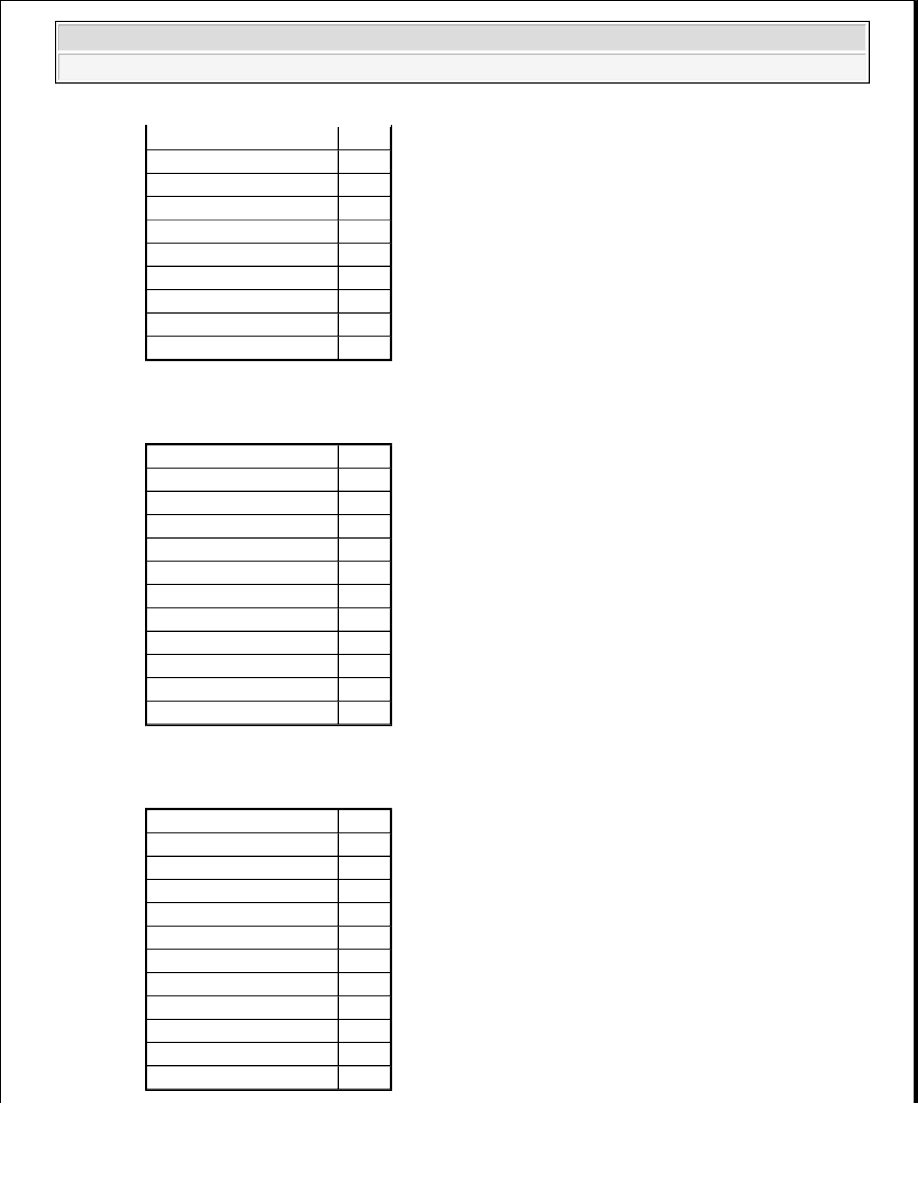Toyota Tundra. Manual — part 1608
2. Clear the DTC (See DTC CHECK/CLEAR ).
HINT:
Even if no DTCs are stored, perform the DTC clear operation to start alcohol concentration learning.
3. Start the engine.
HINT:
After clearing the DTCs, the engine may become difficult to start if the concentration of alcohol in the
fuel is high. Therefore, it may be necessary to crank the engine a few times before it starts.
4. Warm up the engine until the engine coolant temperature is 75°C (167°F) or more [A].
5. Drive the vehicle at 32 km/h (20 mph) or more and maintain a constant speed for 2 minutes or more [B].
6. After this driving make sure that the Data List "Alcohol Density Learning" is "Compl".
7. Drive the vehicle at between 60 and 120 km/h (40 and 75 mph) and maintain a constant speed for at least
10 minutes [C].
8. Drive the vehicle 60 km/h (40 mph) or more and decelerate the vehicle for 5 seconds or more. Perform
this 3 times [D].
9. Turn the Techstream on.
10. Enter the following menus: Powertrain/Engine and ECT/Utility/All Readiness.
11. Enter the following DTCs: P2195, P2196, P2197 and P2198.
12. Check that the DTC monitor is NORMAL. If the DTC monitor is INCOMPLETE, perform the drive
pattern increasing the vehicle speed and using the second gear to decelerate the vehicle [D].
INSPECTION PROCEDURE
HINT:
Although the DTC titles say oxygen sensor, these DTCs relate to the Air-Fuel Ratio (A/F) sensor.
Sensor 1 refers to the sensor mounted in front of the Three-Way Catalytic Converter (TWC) and located
near the engine assembly.
DTC P2A00 may be set when the air-fuel ratio is stuck rich or lean.
Read freeze frame data using the Techstream. Freeze frame data records the engine condition when
malfunctions are detected. When troubleshooting, freeze frame data can help determine if the vehicle was
moving or stationary, if the engine was warmed up or not, if the air-fuel ratio was lean or rich, and other
data from the time the malfunction occurred.
A low A/F sensor voltage could be caused by a rich air-fuel mixture. Check for conditions that would
cause the engine to run rich.
CAUTION: Perform this drive pattern on a level road as much as possible and
strictly observe the posted speed limits and traffic laws while driving.
2009 Toyota Tundra
2009 ENGINE PERFORMANCE Engine Control System (3UR-FBE) - Tundra

A high A/F sensor voltage could be caused by a lean air-fuel mixture. Check for conditions that would
cause the engine to run lean.
HINT:
Malfunctioning areas can be identified by performing the following procedure.
1. Warm up the engine until the engine coolant temperature is 75°C (167°F) or more.
2. Connect the Techstream to the DLC3.
3. Stop the engine.
4. Turn the ignition switch to ON.
5. Turn the Techstream on.
6. Write down the freeze frame data.
7. Clear the DTCs (See DTC CHECK/CLEAR ).
HINT:
Even if no DTCs are stored, perform the DTC clear operation to start alcohol concentration learning.
8. Enter the following menus: Powertrain/Engine and ECT/Data List/Flexible Fuel Vehicle.
9. Record data using snapshots.
10. Start the engine.
HINT:
After clearing the DTCs, the engine may become difficult to start if the concentration of alcohol in the
fuel is high. Therefore, it may be necessary to crank the engine a few times before it starts.
11. Drive the vehicle at 32 km/h (20 mph) or more and maintain a constant speed for 2 minutes or more.
12. After this driving make sure that the Data List "Alcohol Density Learning" is "Compl".
13. When the engine is idling, monitor the output voltages of the A/F and HO2 sensors (AFS Voltage B1S1
and O2S B1S2 or AFS Voltage B2S1 and O2S B2S2) displayed on the Techstream.
Result
RESULT CHART
Result
Main Suspected Trouble Area
A/F sensor output between 3.1 and 3.4 V and 02 sensor output
slowly changes in the range of 0 and 1 V and Aggregate fuel
trim*1 between -20 and 65%
-
A/F sensor output consistently outside range of 3.1 to 3.4 V and
02 sensor output and A/F sensor output contradict each other*2
A/F sensor
A/F sensor heater
A/F sensor circuit
2009 Toyota Tundra
2009 ENGINE PERFORMANCE Engine Control System (3UR-FBE) - Tundra

Sensor Output Reference Values
SENSOR OUTPUT REFERENCE VALUE
Reference values when normal (E0 Fuel)
SENSOR OUTPUT REFERENCE VALUE
Reference values when A/F sensor (Bank 1) is malfunctioning (E0 Fuel)
SENSOR OUTPUT REFERENCE VALUE
A/F sensor output between 3.1 and 3.4 V and 02 sensor output
consistently indicates rich or lean
HO2 sensor
HO2 sensor heater
HO2 sensor circuit
A/F sensor and 02 sensor output both consistently indicate rich or
lean or Aggregate fuel trim*1 less than -20% or Aggregate fuel
trim*1 more than 65%
Injector
Fuel pressure
Gas leak from exhaust system
(Air-fuel ratio extremely rich or
lean)
HINT:
*1: Aggregate fuel trim is approximately equal to the following: Short FT ((1 Long FT/100) x
(1 (Alcohol Density Estimate/2/100)) -1) x 100
*2: For example the A/F sensor output indicates rich while the 02 sensor output indicates lean.
Air-fuel Ratio A/F Sensor
HO2 Sensor
Lean
Higher than 3 25 V Below 0.4 V
Rich
Below 3.25 V
Higher than 0.55 V
AFS Voltage B1 S1
3.28 V
AFS Voltage B2 S1
3.28 V
O2S B1 S2
0.76 V
O2S B2 S2
0.70 V
Short FT #1
1%
Long FT #1
-6%
Short FT #2
2%
Long FT #2
-6%
AF Lambda B1 S1
0.99
AF Lambda B2 S1
0.99
Alcohol Density Estimate 0%
Alcohol Density Learning Compl
AFS Voltage B1 S1
4.99 V
AFS Voltage B2 S1
3.25 V
2009 Toyota Tundra
2009 ENGINE PERFORMANCE Engine Control System (3UR-FBE) - Tundra

Reference values when air leak of the intake system (both banks are lean) (E0 Fuel)
SENSOR OUTPUT REFERENCE VALUE
Reference values when HO2 sensor (Bank 1) is malfunctioning (E0 Fuel)
SENSOR OUTPUT REFERENCE VALUE
O2S B1 S2
0.95 V
O2S B2 S2
0.74 V
Short FT #1
0%
Long FT #1
17.1%
Short FT #2
0%
Long FT #2
-6.3%
AF Lambda B1 S1
1.23
AF Lambda B2 S1
0.99
Alcohol Density Estimate 41%
Alcohol Density Learning Compl
AFS Voltage B1 S1
3.45 V
AFS Voltage B2 S1
3. 6 V
O2S B1 S2
0.03 V
O2S B2 S2
0.03 V
Short FT #1
20.3%
Long FT #1
-1.6%
Short FT #2
19.5%
Long FT #2
-6.3%
AF Lambda B1 S1
1.04
AF Lambda B2 S1
1.08
Alcohol Density Estimate 85%
Alcohol Density Learning Compl
AFS Voltage B1 S1
3.23 V
AFS Voltage B2 S1
3.28 V
O2S B1 S2
0.00 V
O2S B2 S2
0.68 V
Short FT #1
0%
Long FT #1
-1.6%
Short FT #2
2%
Long FT #2
-6.3%
AF Lambda B1 S1
0.99
AF Lambda B2 S1
0.99
Alcohol Density Estimate 0%
Alcohol Density Learning Compl
2009 Toyota Tundra
2009 ENGINE PERFORMANCE Engine Control System (3UR-FBE) - Tundra

Нет комментариевНе стесняйтесь поделиться с нами вашим ценным мнением.
Текст